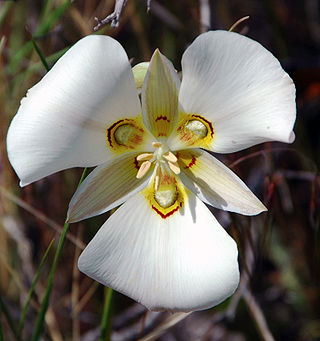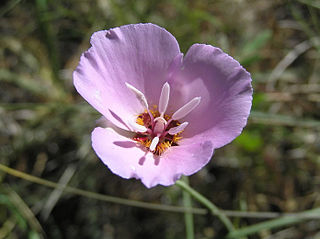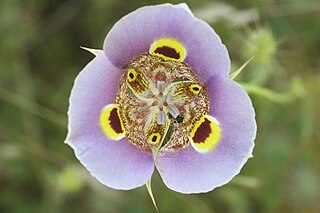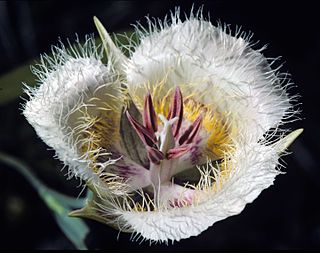
Calochortus is a genus of flowering plants in the lily family. The group includes herbaceous, perennial and bulbous species, all native to North America.

Calochortus luteus, the yellow mariposa lily, is a mariposa lily endemic to California.

Calochortus splendens is a North American species of mariposa lily known by the common name splendid mariposa lily.

Calochortus striatus, known by the common name alkali mariposa lily, is a species of mariposa lily native to California and into Nevada.

Ring Mountain is an elevated landform on the Tiburon Peninsula in Marin County, California. This mountain was named for George E. Ring, who served as a Marin County Supervisor from 1895 to 1903.

Calochortus umbellatus is a flowering plant in the lily family found only in California in the United States. The common name for this species is Oakland mariposa lily or Oakland star-tulip.

Calochortus amabilis is a species of the genus Calochortus in the family Liliaceae. It is also known by the common names Diogenes' lantern, yellow globe-tulip, golden globe-tulip, yellow globe lily, golden fairy lantern, golden lily-bell, Chinese lantern, and short lily.

Calochortus dunnii is a rare species of flowering plant in the lily family known by the common name Dunn's mariposa lily.

Calochortus leichtlinii is a species of flowering plant in the lily family known by the common names Leichtlin's mariposa, smokey mariposa, and mariposa lily.

Calochortus obispoensis is a rare California species of flowering plants in the lily family known by the common name San Luis mariposa lily. It is endemic to San Luis Obispo County, California, where it grows in the chaparral of the coastal mountains, generally on serpentine soils.

Calochortus palmeri is a species of flowering plant in the lily family known by the common names Palmer's mariposa lily and strangling mariposa.

Calochortus persistens is a rare North American species of flowering plant in the lily family known by the common name Siskiyou mariposa lily. It is native to northern California and southern Oregon.

Calochortus superbus is a North American species of flowering plants in the lily family known by the common name superb mariposa lily. It is endemic to California, a common member of the flora in several types of habitat across much of the state. It is most abundant in the Coast Ranges and in the Foothills of the Sierra Nevada.

Calochortus syntrophus is a rare species of flowering plant in the lily family known by the common names Callahan's mariposa lily and clustered mariposa lily. It is endemic to northern California, where it occurs in a remote area north of Montgomery Creek in Shasta County. It has also been spotted in adjacent Tehama County. Its habitat includes open, rocky areas with moist or wet soils in oak woodland territory. It was first discovered in 1993 and its description was published the following year.

Erythronium taylorii is a rare species of flowering plant in the lily family known by the common names Pilot Ridge fawn lily, Taylor's fawnlily, and Yosemite fawn lily. It is endemic to Tuolumne County, California, where it is known only from Pilot Ridge, a remote mountain ridge outside of Yosemite National Park. It was discovered in 1996 and described to science as E. taylori in 1997, and it is now called E. taylorii. There are at least 1000 individuals in the single known population. It occurs on shaded north-facing cliffs.

Calochortus fimbriatus is a California species of flowering plant in the lily family known by the common name late-blooming mariposa lily. It is native to the coastal mountain ranges of southern Monterey, San Luis Obispo, Santa Barbara and northern Ventura counties, where it is a member of the chaparral flora.

Calochortus umpquaensis is a species of flowering plant in the lily family known by the common name Umpqua mariposa lily. It is endemic to Oregon in the United States, where it is mainly limited to the region of the Klamath Mountains on the Little River in Douglas County, in particular the Watson and Ace Williams Mountains. The flower has also been found at a single location in each of Josephine and Jackson Counties.

Calochortus coxii is a rare species of flowering plant in the lily family known by the common names Cox's mariposa lily and crinite mariposa lily. It is endemic to Oregon in the United States, where it is known only from Douglas County.

Calochortus lyallii, or Lyall's mariposa lily, is a North American species of flowering plant in the lily family. It is native and endemic to Province of British Columbia in western Canada, as well as the State of Washington in the northwestern United States. It only grows east of the Cascade crest in the mountains and foothills, and though its numbers are apparently secure in Washington, it is considered to be a blue-listed species in Canada- blue-listed taxa are at risk, but are not extirpated, endangered or threatened. It is found in dry to mesic open forest at lower to middle elevations in the mountains, commonly found with Pinus ponderosa, Pseudotsuga menziesii, Calamagrostis rubescens (pinegrass) and Carex geyeri.




















